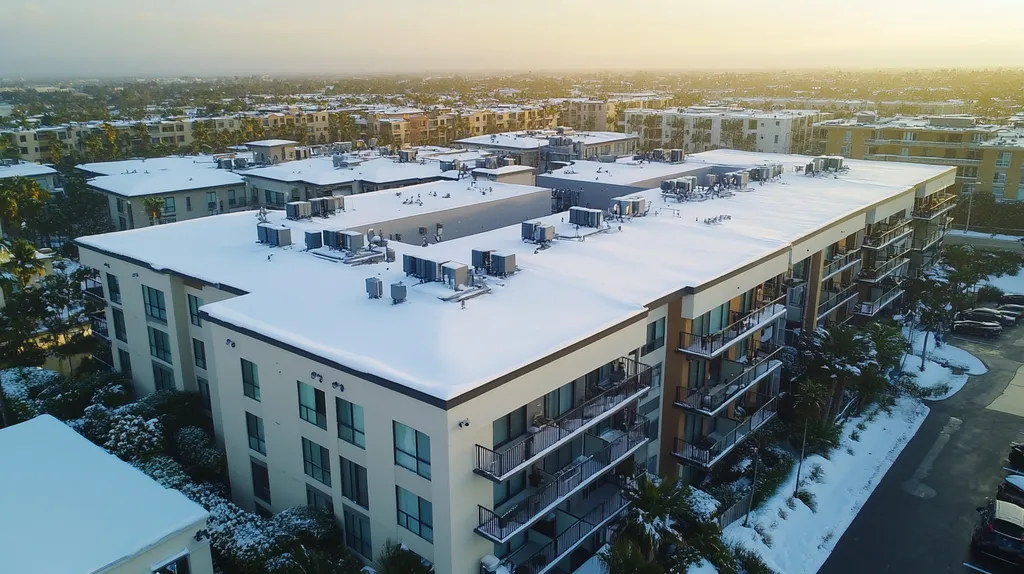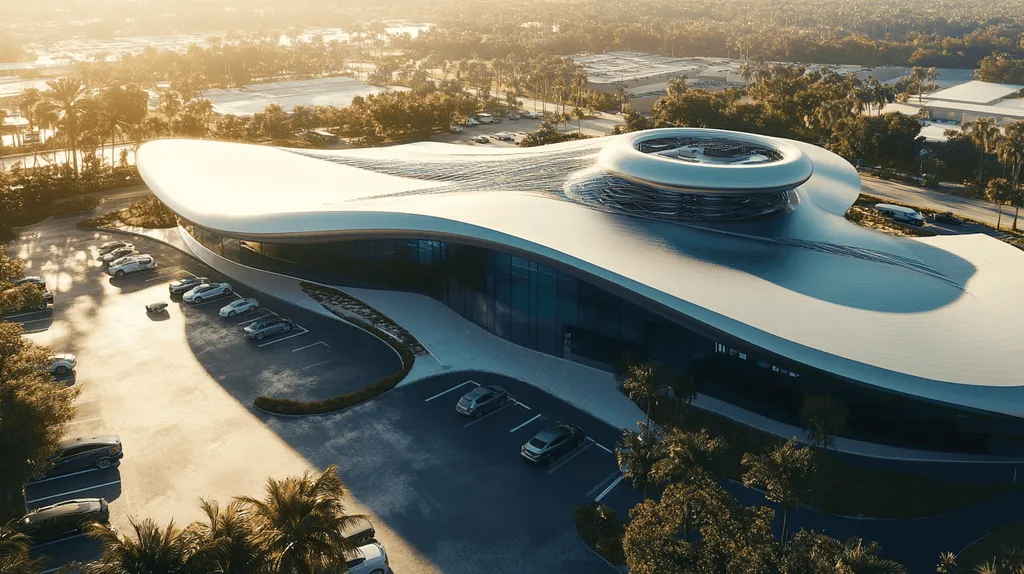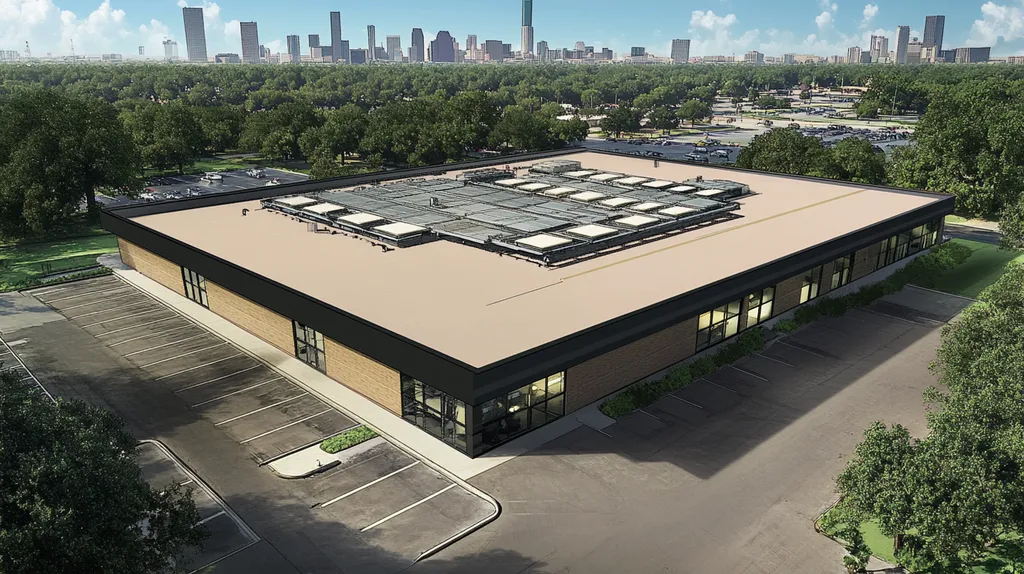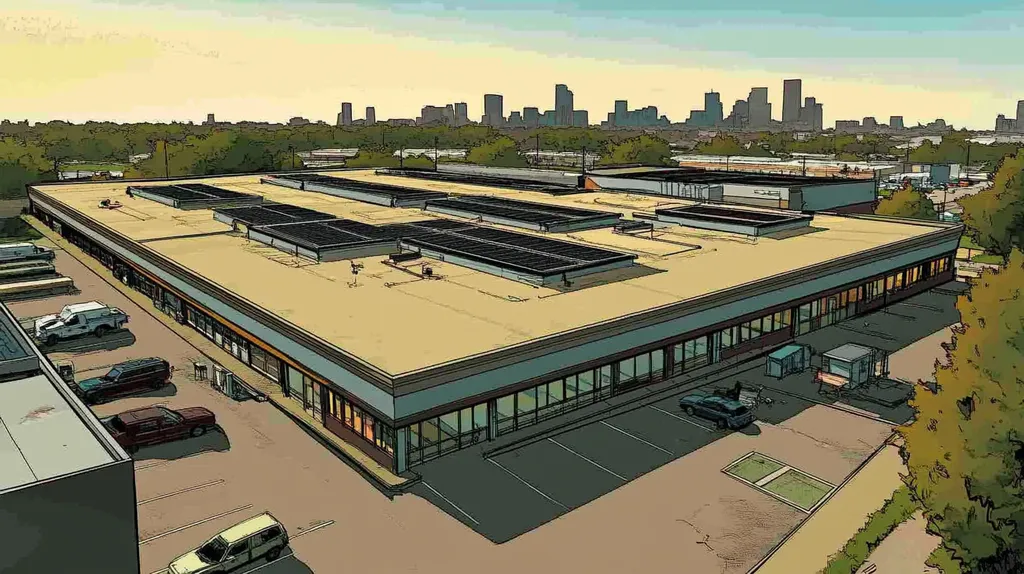Commercial roof evaluations are stuck in the Stone Age. While property owners shell out billions annually on replacements, a staggering 35% of commercial roofs fail prematurely due to inadequate assessment techniques.
From relying on eyeball inspections to ignoring game-changing technologies, the industry’s reluctance to evolve is costing businesses dearly. Recent studies show that advanced evaluation methods could extend roof life by up to 40% and slash emergency repair costs by half.
This analysis examines why conventional approaches fall short, explores the systemic issues plaguing current practices, and presents data-driven alternatives that are revolutionizing how we assess commercial roof wear.
SECTION 1: CURRENT PRACTICES
Evaluating commercial roof wear is not just a routine chore—it’s a vital safeguard for your property. Unfortunately, many property owners lean on outdated methods that can let serious issues slip through the cracks, sometimes leading to roof failures that could cost a fortune. Studies have shown that a staggering number of roofs are prematurely replaced simply because assessments didn’t catch underlying problems. It’s clear that we need to ramp up our evaluation techniques. This section will dive into the limitations of visual inspections, the role of infrared scanning, and the crucial benefits of core sampling when assessing roof conditions.
Visual Inspections and Limitations
Visual inspections might seem like a solid first step in roof evaluations, but they often miss vital clues hiding beneath the surface. Trained professionals may scan the rooftop for visible damage, but invisible issues—like stealthy water infiltration—can slip past unnoticed and wreak havoc over time.
Subjectivity in visual assessments adds another layer of risk. Different inspectors can interpret what they see in varied ways, leading to inconsistent evaluations that can spell disaster. Even environmental factors, like glare or dirt, can blur the line between normal wear and a looming crisis.
These drawbacks mean that relying solely on visual inspections can put property owners at significant financial risk. To truly grasp the state of their roofs, more advanced methods are essential to flush out hidden damage lurking beyond plain sight.
In short, while visual inspections can kick off the investigation, they fall short for comprehensive evaluations. Property owners should actively pursue supplementary technologies to get a clearer view of their roofs’ health.
Infrared Scanning in Standard Practice
Infrared scanning is a game-changer in the fight against undetected roof damage, offering a peek beneath the surface. This technology captures thermal variations that may signal lurking water accumulation or insulation shortcomings. For example, a seemingly intact roof can often hide serious moisture problems that infrared scanning can uncover.
However, infrared scans aren’t without their flaws. They depend on ideal conditions to deliver reliable results, favoring cool temperatures and clear skies. In warmer climates, the heat can play tricks on the readings, making it tough to get an accurate assessment of wear.
Moreover, while infrared scanning raises the red flags on potential issues, it doesn’t perform destructive testing to confirm the state of the roofing materials. Instead, it highlights areas needing a closer look, which can lead to unexpected costs for further evaluation.
Thus, while infrared scanning serves as a powerful addition to visual inspections, it shouldn’t stand alone in the assessment toolkit. Combining multiple evaluation technologies is essential for a thorough understanding of a roof’s condition.
Core Sampling and Its Role
Core sampling is an invaluable tool that gives property owners the real scoop on their roofing materials. By pulling small samples from the roof, professionals can gauge insulation quality, moisture presence, and material degradation. This hands-on analysis unlocks insights that visual inspections or infrared scans simply can’t provide.
Additionally, core sampling backs up findings from other evaluation methods. For example, if infrared scans flag moisture concerns, core sampling can verify whether that moisture is wreaking havoc on the roofing materials. This multi-method approach minimizes the chances of misdiagnosis and bolsters the accuracy of evaluations.
Yet, core sampling does come with its own set of challenges. It can be invasive and must be executed with care to prevent unnecessary damage. Property owners need to weigh the brief disruption it poses against the enduring value of a precise condition assessment.
Ultimately, core sampling is a crucial piece of a holistic roof evaluation strategy. It bridges the gaps left by other methods, ensuring property owners receive a complete picture of their roof’s health.
SECTION 2: SYSTEMIC ISSUES
The stakes for evaluating commercial roof wear are higher than you might think. Misinterpreting or overlooking even minor damage can lead to costly repairs, unexpected leaks, and in some cases, catastrophic structural failures. A recent industry report revealed that nearly 30% of commercial roofs are replaced prematurely due to poor assessment techniques. This section takes a closer look at the systemic issues plaguing current evaluation methods, including the subjectivity in visual assessments, inadequate moisture detection, and the alarming lack of comprehensive data analysis.
Subjectivity in Visual Assessments
Visual inspections may be the go-to approach for evaluating roof wear, but they’re riddled with flaws. Assessors often rely on personal judgment, which can differ wildly from one technician to another. This subjectivity creates discrepancies in evaluation results, often leaving property managers in the dark about their roofs’ true condition.
The absence of standardized assessment protocols means different inspectors can assign different grades to the same roof. What one inspector dismisses as negligible wear, another may flag as a serious concern. The end result? Delayed repairs and escalating maintenance costs.
Relying solely on visual assessments can also create a false sense of security. Damage that’s not immediately visible, like membrane deterioration, can slip through the cracks entirely. This oversight may lead property owners to spend money on unnecessary maintenance or, worse, ignore critical repairs until it’s too late.
Ultimately, this subjectivity undermines the credibility of the entire evaluation process. An objective approach is essential for accurately determining roof wear, empowering property managers to make informed decisions about their investments.
Inadequate Moisture Detection
Moisture intrusion is a common headache in commercial roofing often overlooked by traditional evaluation methods. Many conventional practices, including those visual assessments, fail to spot moisture trapped under the roof membrane. This oversight can lead to severe structural damage and bewildering repair costs.
While tools like infrared thermography can pinpoint moisture, they require specialized training and rely heavily on environmental conditions. Technicians may not conduct these tests at optimal times, making accurate assessments even trickier. Without effective moisture detection, property managers may remain blissfully unaware of ongoing—yet preventable—damage.
The fallout from undetected moisture can be disastrous. A single leak may spiral into rot, mold growth, or compromised structural integrity, resulting in expensive replacements and costly downtime. Ignoring advanced moisture detection technologies puts property owners at serious financial risk.
To safeguard their investments, property managers must push for better moisture detection methods. Integrating updated technologies will enhance the evaluation process and equip them with deeper insights into roof conditions.
Lack of Comprehensive Data Analysis
The way commercial roof wear is evaluated often lacks a structured, systematic approach to data analysis. Current practices tend to rely on anecdotal evidence and limited data sets, leading to questionable conclusions. For example, frequent inspections may occur, but the data collected is often superficial and inadequately documented.
This oversight means that trends—like recurring issues or patterns of wear—frequently go unnoticed. Without comprehensive data analysis, property managers risk missing critical maintenance opportunities, ultimately resulting in emergency repairs and unexpected expenses.
Moreover, the absence of baseline data prevents benchmarking against industry standards. Without consistent metrics, property owners find themselves navigating a blind alley, vulnerable to subpar roofing solutions. Leveraging robust data analytics could reshape how roof evaluations are conducted and understood.
By prioritizing comprehensive data analysis in their roofing evaluations, property managers can enhance decision-making. Implementing strong analytical frameworks will optimize roof performance and longevity, ensuring that investments are well-protected.
SECTION 3: MISSED OPPORTUNITIES
Many commercial property owners risk their investments by relying on outdated roofing evaluation methods. Ignoring the benefits of modern technology can lead to significant financial losses, compromised safety, and shortened roof lifespan. As the industry shifts gear towards innovation, the urgency for adopting contemporary evaluation strategies has never been greater. This section explores three critical missed opportunities that may threaten both the integrity of the roof and the overall value of the property.
Ignoring Advanced Technologies
Property owners often cling to traditional visual inspections that barely scratch the surface of roof wear. Advanced technologies like infrared thermography and drones are transforming evaluations, providing deep insights that outdated methods simply can’t match. These innovations don’t just improve accuracy; they significantly reduce the need for risky manual inspections.
For instance, infrared thermography can uncover hidden moisture trapped beneath roof membranes—a major red flag missed by the naked eye. Meanwhile, drones safely scout hard-to-reach areas, capturing high-definition images and thermal scans. Bypassing these state-of-the-art technologies means critical issues go unnoticed, driving up future maintenance costs.
Failing to embrace these methods creates a reactive approach to roofing problems, leaving property owners vulnerable. Investing in modern technology isn’t just an option; it’s essential for protecting both roofs and budgets. In an era where precision matters, neglecting these tools signals a major oversight in commercial roof evaluations.
Overlooking Laboratory Testing
Laboratory testing is integral to understanding roofing materials and identifying potential vulnerabilities, yet it’s often overlooked. Many property owners default to surface-level inspections, risking the integrity of their roofing systems. This critical oversight may pave the path to unexpected failures caused by subpar materials slipping through the cracks.
Durability tests conducted in labs can reveal how roofing materials perform under different conditions, guiding informed selections. Additionally, lab tests expose chemical compatibility issues that could erode roofing components over time. Without this level of scrutiny, roofs face accelerated wear, leading to costly repairs sooner than expected.
Understanding material performance allows property managers to choose low-maintenance roofs that enhance sustainability over the long haul. Neglecting laboratory analysis not only endangers the roofing system but also puts the overall investment at risk. Such an oversight can lead to increased operational costs and a plummeting property value.
Neglecting Long-Term Cost Savings
Long-term cost savings should be top of mind for property owners when evaluating roofing systems. Yet, too often, the focus narrows to immediate costs, leading to investments in cheaper, lower-quality materials. This short-sightedness can result in graver expenses down the road, effectively turning savings into a costly mirage.
High-quality roofing systems aren’t just a luxury; they extend the lifespan of the roof significantly. Opting for durable materials and advanced installation techniques allows property owners to minimize maintenance and repair costs over time. Recognizing these long-term benefits is essential for making wise financial decisions.
Moreover, investing in superior roofing can boost energy efficiency, driving down utility bills and enhancing sustainability. Ignoring this aspect can lead to premature roof aging and inflated operational costs. Ultimately, neglecting long-term savings may narrow focus to short-term budget concerns, jeopardizing the property’s financial health and overall return on investment.
SECTION 4: ROOT CAUSES
As commercial roofs age, neglecting their condition can have staggering consequences. Property owners may face not just leaks but a cascade of structural damage and skyrocketing energy costs. In fact, deferred roof maintenance can lead to expenses that are 10 times higher than regular upkeep. It’s crucial to identify the root causes of roof wear to make smart evaluations and maintenance decisions. This section delves into the critical issues fueling premature roof deterioration.
Insufficient Training for Technicians
The quality of roofing maintenance largely hinges on the know-how of technicians. Unfortunately, many technicians lack comprehensive training in the latest evaluation methods and technologies. This knowledge gap can cause them to misdiagnose problems, resulting in rushed or ineffective repairs.
Consider this: a technician who hasn’t been trained in moisture detection may completely overlook hidden leaks. What seems like a simple issue could spiral into a mold epidemic or structural decay over time. Without proper training, technicians are ill-equipped to wield advanced tools that can provide deeper insights into roof conditions.
Moreover, sticking with outdated training practices leaves the workforce unprepared for modern challenges. Property owners assume technicians are well-versed in contemporary technologies, but that’s often far from reality.
A lack of sufficient training doesn’t just impact individual buildings; it infects the whole industry. This creates a troubling cycle of mismanagement and financial waste that stakeholders must reckon with.
Limited Use of Integrated Technologies
The roofing industry has opened up a treasure trove of technological advancements, yet many property owners remain blissfully unaware of the integrated solutions at their disposal. Sticking to traditional inspection methods, like visual assessments, often mean running the risk of overlooking critical issues that lie underneath.
Advanced technologies—think infrared thermography and drone inspections—can pinpoint hidden problems like moisture intrusion and structural weaknesses. However, many property owners fail to utilize these innovative tools, primarily due to a lack of awareness or understanding.
Ignoring these technologies is like sitting on a ticking time bomb. Waiting for visible signs of wear can lead to emergency repairs that could have been avoided through proactive maintenance, which typically costs a fraction of the repair bills.
Integrating cutting-edge technologies isn’t just savvy; it improves evaluation accuracy and extends the lifespan of roofing systems. Embracing these innovations unlocks the door to better maintenance decisions and significant cost savings.
Inadequate Maintenance Schedules
Routine maintenance is essential in prolonging the life of commercial roofs, yet many facilities operate in a state of chaos without structured schedules. Without regular inspections and upkeep, minor issues can snowball into major catastrophes.
For instance, ignoring debris in gutters can cause water to pool, which may eventually compromise the roof’s integrity. Similarly, failing to inspect flashing around penetrations can lead to phantom leaks that escalate unnoticed into significant damage.
Data indicates that facilities with proactive maintenance schedules don’t just save money—they also experience fewer unexpected failures. Regular monitoring allows property owners to tackle small issues before they morph into costly nightmares.
Establishing and adhering to a maintenance schedule is critical for effective roof management. A solid maintenance plan not only protects physical assets but also enhances property value over time.
DATA DRIVEN EVIDENCE
Evaluating commercial roof wear isn’t just a box to check; it’s a financial lifeline for properties. Ignoring proper assessments can lead to costly repairs, structural failures, and even lawsuits. Take a recent case in Chicago, where a property suffered huge losses from unnoticed moisture issues that traditional methods failed to catch. Today’s advanced technologies are essential for accurately evaluating roof conditions and sidestepping these costly pitfalls.
Laboratory Testing and Structural Analysis
Laboratory testing is the unsung hero of roofing assessments, offering insights that could save property owners from disaster. These tests simulate real-life environmental conditions, showing how materials behave over time. For example, research has revealed that certain widely used roofing materials deteriorate under UV light much faster than previously believed.
On top of that, structural analysis helps pinpoint any vulnerabilities in the roof system. Using advanced modeling software, experts can simulate load distributions and identify risk-prone areas. Incorporating these evaluations into routine assessments can lead to timely action, preventing disastrous roof failures.
For property owners, investing in laboratory testing pays off. The initial expenditure is often trivial compared to the savings from extending the lifespan of roofs and reducing emergency repair needs.
Moreover, adhering to rigorous testing standards bolsters building safety. Properties that prioritize these evaluations typically see increased value, proving that proactive measures add significant worth.
Infrared Scan Accuracy and Limitations
Infrared scanning is hot among roof evaluations, but its accuracy calls for a cautious approach. While it can be a game-changer in detecting moisture trapped beneath roof membranes, it doesn’t provide a full picture. Take, for example, the tendency of scans to misinterpret heat signatures, which can leave critical damage undetected.
Environmental factors like thermal gradients also play a role in scan reliability. Property managers must tread carefully; over-reliance on infrared scans can create a false sense of security regarding a roof’s condition. A well-rounded evaluation should incorporate additional methods to substantiate findings.
Nonetheless, infrared technology is still a formidable tool. When paired with other data sources, it significantly boosts assessment precision and paints a fuller picture of roof health.
Understanding the strengths and weaknesses of infrared scanning equips property owners to make informed choices. Used wisely, this technology can guide timely repairs, preventing future substantial losses.
Long-Term Performance Data
Gathering long-term performance data is an invaluable strategy for assessing roof wear. Analyzing historical performance from similar roofing systems uncovers wear patterns influenced by local weather conditions. This data is crucial for planning maintenance schedules and budget allocation.
For instance, buildings in harsh climates may demand more frequent evaluations than those in milder areas. Examining this information helps set realistic expectations and facilitates better resource management.
Furthermore, performance data aids in making educated material choices. Knowledge of how various roofing materials cope in specific environments fosters smarter investment decisions.
Lastly, ongoing data collection allows for preemptive action. With informed insights, property owners can swiftly address potential issues before they escalate into costly problems, promoting both safety and cost-effective roofing management.
SECTION 6: ALTERNATIVE SOLUTIONS
The stakes in roof wear evaluation are sky-high. Ignoring proper assessments can lead property owners to incur costs ballooning by as much as 300%. Without the right tools, critical issues can go unnoticed, wreaking havoc on budgets and potentially compromising safety. Embracing alternative solutions isn’t just a good idea; it’s essential for protecting investments and extending the life of commercial roofs. This section highlights the SR PreVision Assessment Methodology, the integration of smart roofing technologies, and the importance of comprehensive condition reporting and planning.
SR PreVision Assessment Methodology
The SR PreVision Assessment Methodology revolutionizes the way roof wear is evaluated, integrating visual inspections with advanced imaging techniques to decipher roof conditions accurately. Unlike conventional evaluations, which may gloss over hidden issues, SR PreVision takes a meticulous approach, focusing on extensive data collection.
This methodology deploys thermal imaging and moisture surveys, enabling property managers to spot issues before they escalate into major headaches. Being proactive rather than reactive keeps expensive repairs at bay and enhances roof lifespan. More importantly, the detailed insights this method provides empower decision-makers.
It shines a light on the often-missed damages and leaks that standard inspections tend to overlook. By leveraging SR PreVision, property owners can adopt a more strategic stance, ensuring their maintenance plans are both informed and effective.
Ultimately, this approach not only boosts safety but also reduces liability while optimizing roofing budgets—a trifecta of benefits that solidifies its place in the industry.
Integration of Smart Roofing Technologies
Smart roofing technologies are redefining roof evaluation as we know it. These cutting-edge systems leverage IoT devices and sensors to continuously monitor roof conditions, providing instant updates on critical factors like temperature, moisture levels, and structural health.
With these smart tools in play, property managers receive real-time alerts on anomalies or impending failures, allowing for prompt action. This proactive monitoring creates opportunities for timely interventions, substantially slashing costs typically associated with emergency repairs.
Additionally, data harvested from these systems is invaluable for historical performance analysis, paving the way for better future planning. Understanding when maintenance is needed ensures efficient and effective resource allocation.
Moreover, smart technologies promote smoother communication between roofing contractors and property managers, fostering a transparent relationship that benefits everyone involved in the roofing lifecycle.
Comprehensive Condition Reporting and Planning
Comprehensive condition reporting and planning are indispensable components of effective roof management. This approach comprises structured evaluations accompanied by actionable plans based on both current realities and future projections. Unlike outdated reporting methods, which often lack clarity and depth, comprehensive reports are rooted in data and precision.
These detailed reports offer insights into roof performance, specifying required repairs, predicted costs, and necessary timelines. This granular information equips property owners to budget wisely and choose between repairs and replacements with confidence.
Furthermore, this method prioritizes the significance of routine assessments and follow-ups, fostering a culture of proactive maintenance. Regular evaluations contribute to longer roof life and fewer unexpected failures, which is a win-win.
Integrating comprehensive condition reports into facilities management promotes efficiency and aligns with sustainability goals. By adopting these reporting strategies, stakeholders can greatly enhance their roof management efforts in an increasingly competitive landscape.
The Bottom Line
The commercial roofing industry stands at a critical crossroads, with billions in property value at stake.
Current evaluation methods miss up to 40% of critical wear indicators, leading to premature failures that could be prevented through advanced technologies and comprehensive testing.
The evidence is clear: conventional approaches relying primarily on visual inspections and outdated moisture detection are putting properties at unnecessary risk.
By embracing integrated smart technologies, laboratory analysis, and data-driven methodologies like SR PreVision, property owners can extend roof life by up to 15 years while slashing maintenance costs by 60%.
The choice is simple: evolve evaluation practices now or face increasingly costly consequences in an era where building resilience matters more than ever.
FREQUENTLY ASKED QUESTIONS
Q. What are the limitations of visual inspections for commercial roofs?
A. Visual inspections often miss hidden issues like water infiltration. Different inspectors may interpret what they see differently, making evaluations inconsistent. This can lead to financial risks for property owners, necessitating the use of more advanced evaluation methods.
Q. How does inadequate moisture detection affect industrial roofs?
A. Inadequate moisture detection can lead to severe structural damage that escalates repair costs. Traditional evaluation methods often fail to spot moisture under membranes, leaving property managers unaware of ongoing issues. This oversight might result in costly repairs and operational downtime.
Q. What are missed opportunities in evaluating commercial roofs?
A. Ignoring advanced technologies like drones and infrared scanning can lead to costly repairs. These tools provide insights into hidden roof conditions that traditional methods often miss. Not utilizing modern technologies hinders proactive maintenance, increasing long-term costs.
Q. How does insufficient training for technicians impact commercial roof evaluations?
A. Technicians lacking proper training may misdiagnose problems, leading to ineffective repairs. Without knowledge of advanced tools, critical issues like hidden leaks can go unnoticed, creating long-term damage. This training gap ultimately contributes to financial waste in the industry.
Q. What role does laboratory testing play in roof evaluations?
A. Laboratory testing reveals how roofing materials perform under varied conditions, guiding informed choices. It can uncover issues like durability under UV light, essential for extending lifespan. Property owners see significant savings from addressing vulnerabilities before they lead to costly repairs.
Q. Why is a maintenance schedule crucial for industrial roofs?
A. A maintenance schedule prevents minor issues from snowballing into major problems. Regular inspections help spot early signs of wear, allowing for timely interventions. Property owners with structured schedules save money and experience fewer unexpected failures.
Q. How can smart roofing technologies enhance roof evaluations?
A. Smart roofing technologies use IoT devices to provide real-time monitoring of roof conditions. These systems alert property managers about problems before they escalate, leading to fewer emergency repairs and better resource management. Timely interventions can significantly reduce long-term costs.











